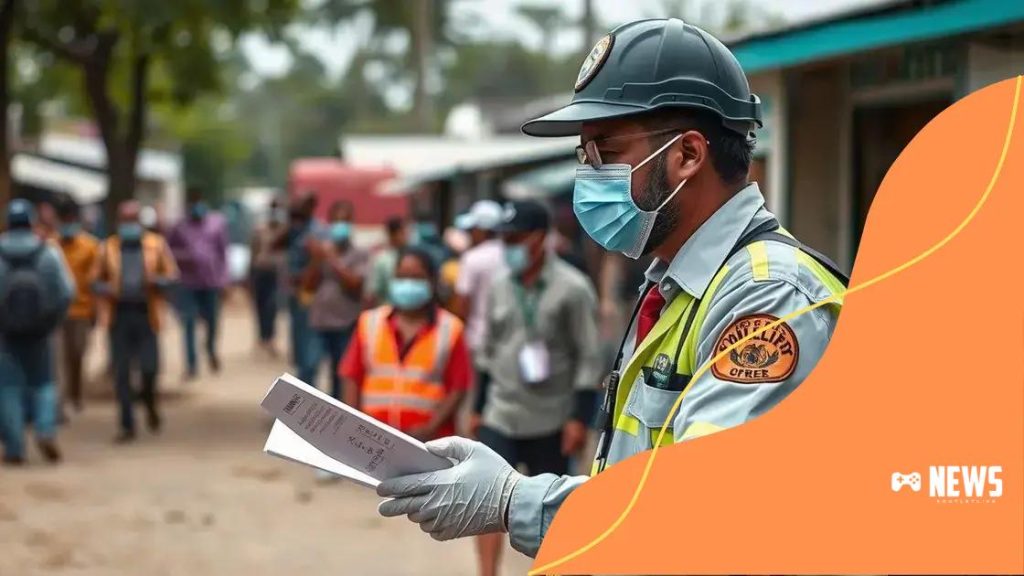Public health emergency responses: how to stay prepared

Preparing your community for future emergencies involves developing clear emergency plans, conducting regular training, engaging residents, and collaborating with local organizations to ensure effective response and resilience during crises.
Public health emergency responses are essential for protecting community health during crises. But how aware are we of their importance? Let’s dive into what makes these responses effective and why preparedness is key.
Understanding public health emergencies
Understanding public health emergencies is crucial for everyone. These situations can arise from various sources, including natural disasters, outbreaks of diseases, or bioterrorism. Recognizing the different types of emergencies helps communities respond effectively and timely.
Types of Public Health Emergencies
There are several categories of public health emergencies. Each type presents unique challenges that require specific responses. Here are some common examples:
- Natural Disasters: Events such as hurricanes or earthquakes can severely impact public health resources.
- Infectious Disease Outbreaks: Epidemics like influenza or COVID-19 demand immediate public health interventions.
- Bioterrorism: Deliberate attacks using harmful biological agents can create widespread panic and health crises.
- Environmental Hazards: Issues like chemical spills can pose immediate health risks to affected populations.
Understanding these emergencies enables communities to prepare for the unexpected. Education is a key component in public health preparedness. When people know what to expect, they can take appropriate precautions.
The Role of Communication
Effective communication is vital during public health emergencies. Clear messaging helps reassure the public and keeps them informed. Community leaders should prioritize timely updates about risks and safety measures. This creates a sense of trust and encourages collective action.
Moreover, utilizing various platforms, such as social media and local news, can enhance outreach. It’s important that messages are consistent and understandable, as confusion can lead to panic and hinder response efforts.
Many organizations also conduct drills and simulations to prepare both responders and community members for emergencies. These exercises allow individuals to practice their responses, reinforcing knowledge and improving coordination.
Supporting public health initiatives in your community can also make a significant difference. Understanding the health resources available allows individuals to act swiftly when emergencies arise. Whether it’s knowing where to get vaccines or who to contact during a health crisis, being informed is empowering.
By fostering a culture of preparedness, we can mitigate the effects of public health emergencies. It’s not just about individual safety but about the community as a whole working together.
Key components of an effective response
Key components of an effective response to public health emergencies involve coordination, communication, and preparedness. Having a well-structured plan can make all the difference during a crisis.
Coordination Among Agencies
Strong coordination between local, state, and federal agencies is essential. By sharing resources and information, these agencies can respond faster and more efficiently.
- Clear Roles: Each agency should know its responsibilities.
- Resource Sharing: Combining resources helps manage crises more effectively.
- Joint Training: Regular training exercises can enhance cooperation between different organizations.
When agencies work together seamlessly, it reduces confusion and ensures that the public receives timely assistance.
Effective Communication
Another crucial component is effective communication strategies. Keeping the public informed can prevent panic and misinformation.
Utilizing various platforms allows authorities to spread vital information quickly. Communities can benefit from:
- Social Media: Real-time updates through platforms like Twitter and Facebook.
- Press Releases: Official statements from public health officials can clarify situations.
- Community Meetings: Engaging directly with the community fosters trust.
When people receive clear messages, they are more likely to follow recommended health guidelines.
Another important factor is the readiness of healthcare systems. Hospitals and clinics need to be prepared for sudden surges in patients during emergencies. This means having enough staff, medical supplies, and facilities to handle an influx of cases.
Lastly, public awareness and education play a significant role in effective responses. Communities that understand health risks and appropriate actions to take are better equipped to respond to emergencies. Educational campaigns can ensure that vital information reaches everyone.
By creating a culture of preparedness and responsiveness in public health, communities strengthen their resiliency against future emergencies.
Lessons learned from past public health crises

Lessons learned from past public health crises are invaluable for improving future responses. By analyzing what worked and what didn’t, we can enhance our preparedness and resilience.
Evaluation of Past Responses
Every public health emergency brings unique challenges. Reviewing past crises helps identify successful strategies and areas needing improvement.
- Case Studies: Examining crises like the Ebola outbreak teaches valuable lessons about containment and communication.
- Data Analysis: Gathering data from past responses can guide better decision-making in real-time situations.
- Community Feedback: Engaging with communities affected by past crises reveals critical insights into public perception and needs.
Recognizing these elements can help public health officials craft more effective plans for the future. In many cases, the importance of **rapid response** and mobilization becomes evident.
Importance of Preparedness
Preparation is key to mitigating the effects of public health emergencies. Lessons show that well-prepared communities can react more swiftly and effectively.
Some aspects of preparedness include:
- Emergency Response Plans: Developing clear plans ensures everyone knows their roles during a crisis.
- Training Programs: Ongoing training helps responders maintain their skills and stay updated on best practices.
- Resource Allocation: Having resources readily available can speed up response times.
More importantly, we learn that communication with the public is essential. During crises, clear messaging can reduce panic and misinformation, ultimately saving lives.
Past experiences highlight the need for collaboration among organizations. When various entities, including government, non-profits, and healthcare providers, work together, responses are often more effective.
Combining efforts leads to shared resources, information dissemination, and enhanced support for those in need. As we look ahead, these lessons must inform our strategies for responding to future public health emergencies.
Role of community engagement in emergency responses
The role of community engagement in emergency responses is vital for effective public health management. When communities are involved, the overall response improves significantly.
Building Trust Through Engagement
Engaging the community helps build trust between public health officials and residents. Trust is crucial, especially during crises, as it encourages people to follow health guidelines.
- Open Communication: Regular updates and transparent communication can foster a sense of security.
- Feedback Mechanisms: Allowing community members to provide feedback helps officials understand their concerns.
- Involvement in Planning: Involving community members in emergency planning can increase buy-in and ensure the plans meet local needs.
When people feel their voices matter, they are more likely to be engaged and proactive during emergencies.
Mobilizing Community Resources
Communities have unique resources and strengths that can be tapped during emergencies. Many neighborhoods possess a wealth of knowledge and skills that contribute to effective responses.
Some key aspects include:
- Local Organizations: Non-profits and community groups often mobilize quickly and efficiently.
- Volunteers: Engaged citizens can serve as volunteers for relief efforts, providing hands-on support.
- Neighborhood Networks: Informal networks support information sharing and resources during crises.
By harnessing these local assets, public health officials can create a more resilient response system. Community engagement not only enhances trust but also builds a sense of ownership among residents.
Furthermore, engaging communities can lead to tailored interventions that resonate better with those affected. When health strategies align with community values, they tend to be more effective and accepted.
Action steps, like hosting community meetings or forming task forces, allow residents to take an active role, transforming them from passive recipients to active participants in their health security.
Preparing your community for future emergencies
Preparing your community for future emergencies is essential for minimizing disruption and protecting public health. Communities that are proactive about planning and education can respond more effectively when crises occur.
Developing Emergency Plans
Creating a comprehensive emergency plan is the first step toward readiness. This plan should outline roles, responsibilities, and procedures for various types of emergencies.
- Risk Assessment: Identifying potential risks specific to the community can help tailor the emergency plan.
- Clear Procedures: Establish protocols for how to respond to different scenarios, such as natural disasters or disease outbreaks.
- Regular Updates: Plans should be reviewed and updated regularly to incorporate new information and lessons learned.
These steps facilitate better organization and ensure that everyone knows their role during an emergency situation.
Community Training and Drills
Training is crucial for effective preparedness. Regular drills and educational sessions help community members understand how to react during an emergency.
Some advantages of community training include:
- Increased Awareness: Training raises awareness about potential hazards residents might face.
- Confidence Building: Knowing what to do in a crisis empowers individuals and reduces panic.
- Teamwork Skills: Drills promote teamwork, enhancing community cohesion and collaboration.
By participating in these activities, residents feel more connected and invested in the well-being of their community.
Having a robust communication strategy is another critical aspect of preparedness. Communities should set up channels to share timely information in emergencies. Whether through social media, community meetings, or local news, keeping everyone informed can reduce fear and confusion.
Lastly, collaboration with local organizations can strengthen community preparedness. Non-profits, schools, and businesses can provide support and resources during emergencies. Forming partnerships allows communities to leverage each other’s strengths for a more effective response.
FAQ – Frequently Asked Questions about Community Preparedness for Emergencies
Why is it important to have an emergency plan?
An emergency plan ensures everyone knows their roles and responsibilities, helping the community respond effectively during a crisis.
How can training help my community prepare?
Training increases awareness and confidence, enabling community members to act quickly and effectively when emergencies occur.
What role does communication play in emergency response?
Effective communication helps keep the community informed and reduces panic, ensuring that residents know what actions to take.
How can local organizations contribute to preparedness?
Local organizations can provide resources, volunteers, and expertise, creating a stronger support network during emergencies.





